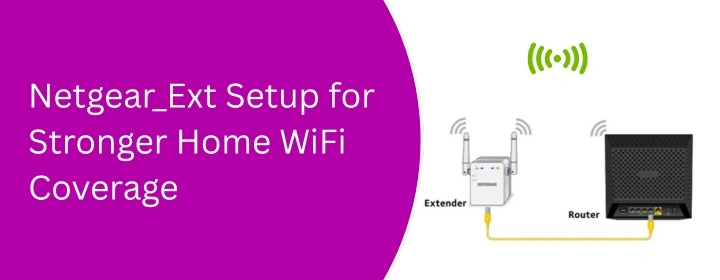Having weak WiFi at home might make you crazy. You move a few rooms away from your Wifi, and all of a sudden, your video call stops working or Netflix goes down to low quality. In such cases, using a range extender could be the best solution. Netgear devices usually have a network name of netgear_ext.
This article is about getting netgear_ext to work well so you don’t have to sit near to your router all the time to get a good signal.
The Issue with WiFi Coverage
There are restrictions to every router. Walls, floors, and other electronics make the signals weaker as they go through them. The dead zones become quite apparent very quickly if you live in a big house or even a tiny apartment with strong concrete walls. The speeds are lightning fast in one section of the home, while the rear bedroom doesn’t receive any signal at all.
WiFi is radio waves, not magic. Like all waves, they dissipate, scatter, and obstruct. That’s why your laptop could operate perfectly in the kitchen but not in the garage.
The Router Can Only Do So Much
Routers are designed to stay in one spot and send out coverage. You can extend the range if you have a high-end one with more than one antenna, but there is still a limit.
You can still notice dead areas even if you move the router, such as putting it in the center of the home, away from microwaves and cordless phones. You can’t always rely on the router if you want coverage everywhere, even in the basement, attic, or distant corner room.
The Extender comes in
This is where WiFi boosters or extenders come in. They don’t replace your router; they only make the signal stronger. The extender receives the router’s WiFi signal and sends it out under its own name, usually _EXT.
People like Netgear because its extenders are easy to use. The network you join to during setup is called netgear_ext. Once it’s set up, it will transmit WiFi signals from your router to places it couldn’t reach previously.
Steps to Set Up: Connecting to Netgear_Ext
Let’s get to the point. Setting up isn’t hard, but you do need to do it in the right sequence. This is how it normally goes:
- Connect It: Choose an outlet that is midway between your router and the dead zone. Don’t put it in the very corner where there isn’t a signal; it won’t help.
- Look for Netgear_Ext: Check to see if there are any WiFi networks accessible on your phone, tablet, or laptop. You will notice one with the name netgear_ext. That is the temporary setup network for the extender. Get in touch with it.
- Go to the Browser Login Page: After connecting, type mywifiext.net or 192.168.1.250 into a browser. This opens the extender login page.
- Make a login name and password: You will need to create a username and password for the extender itself the first time you use it. These are different from the ones on your router. Don’t think about it too much; simply choose something that will stick in your mind.
- Connect to the WiFi on your router: The extender will look for networks that are open. Choose your home WiFi from the list, type in the password, and click “OK.”
- Wait for Sync: It will flash lights for a while. Green normally signifies good, amber means okay, and red means terrible. You’re good to go when it’s solid green.
- Plug the devices back in: Depending on the model, your extended WiFi can show up as “HomeWiFi_EXT.” When you’re in a dead zone, connect your phone or laptop to that one.
That’s all. You’ve successfully extended your existing network!
The Extender’s Login Page
After setting up, don’t forget about the login portal. You may go back there a few times. You may need to upgrade the firmware, modify the settings, or even the password for the extension. When you’re connected to the extender network, you can go to it via mywifiext.net.
Some people never touch it again, but it’s wise to maintain the firmware up to date. Netgear sends out updates to fix security flaws and make things run better. Yes, even extenders may have problems.
Mistakes That People Often Make
Even though it’s easy to set up, but technical errors do happen. Here is how you can resolve them:
- Putting the Extender Too Far: If the extender only gets a weak signal from the router, it can’t send out much. Put it where the router’s WiFi is still good, not where it’s entirely dead.
- Not updating firmware: Extenders might be buggy if their software is out of current. A short login and update may save a lot of trouble.
- Not remembering the password to log in: This occurs more often than you may expect. People make a fast password for the extension and then forget it. If that’s you, you’ll have to use the small pinhole reset button to reset the extender.
- Using the Wrong Network After Setting Up: Some devices could continue attempt to connect to the poor signal from your previous router, even when the extender is there. Make sure you link them to the “_EXT” network manually.
Wrap Up
The netgear_ext setup is mainly only for filling in the holes that your router can’t handle. Once you realize that the extender is merely replicating your WiFi, it all makes sense. The key is to put everything in the right location and not speed through the login process.
Don’t anticipate miracles; extenders can’t make your internet quicker than what your ISP gives you. But they can keep your connection stable in more rooms, which is what most people truly require.
Setting up netgear_ext could be the easiest thing you’ll ever do if you’re weary of walking around the house looking for the “good WiFi spot.”

